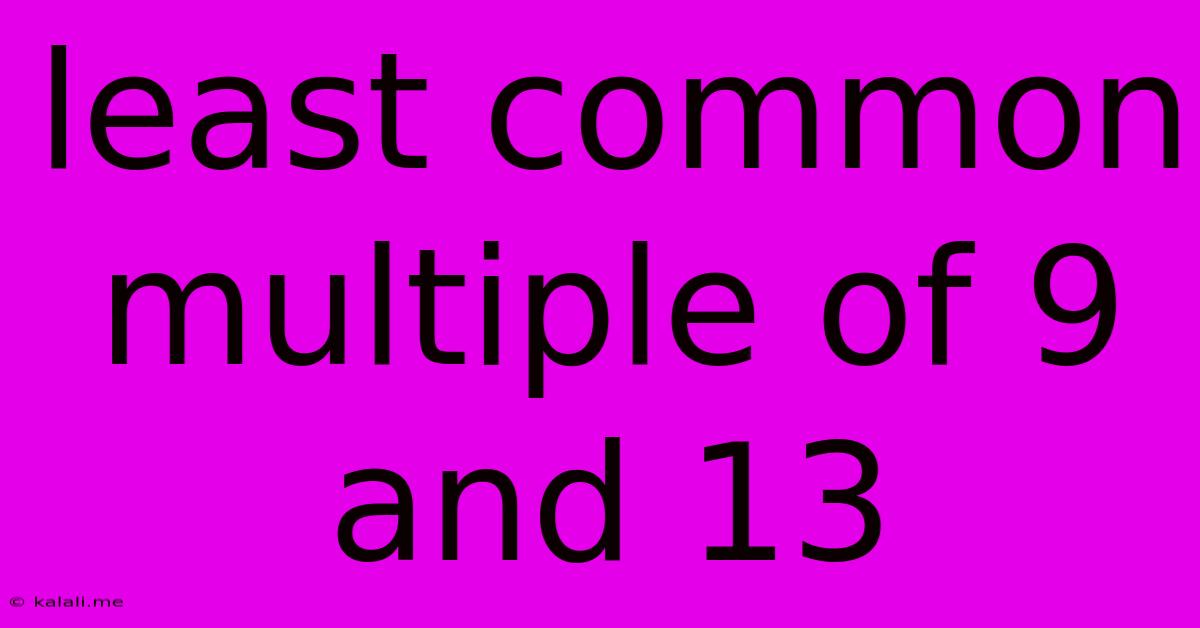Least Common Multiple Of 9 And 13
Kalali
Jun 14, 2025 · 2 min read

Table of Contents
Finding the Least Common Multiple (LCM) of 9 and 13: A Simple Guide
Finding the least common multiple (LCM) might seem daunting, but it's a straightforward process once you understand the underlying concepts. This article will guide you through calculating the LCM of 9 and 13, explaining the methods involved and offering insights into the broader applications of LCMs in mathematics. Understanding LCMs is crucial for various mathematical operations, from simplifying fractions to solving problems in algebra and number theory.
What is the Least Common Multiple (LCM)?
The least common multiple (LCM) of two or more integers is the smallest positive integer that is divisible by all the integers. In simpler terms, it's the smallest number that contains all the numbers as factors. Think of it as the smallest number that can be evenly divided by both (or all) of the given numbers without leaving a remainder.
Methods for Calculating the LCM of 9 and 13
There are several methods for finding the LCM, and we'll explore two of the most common approaches:
Method 1: Listing Multiples
This method is best for smaller numbers. We list the multiples of each number until we find the smallest multiple common to both.
- Multiples of 9: 9, 18, 27, 36, 45, 54, 63, 72, 81, 90, 99, 108, 117, 117...
- Multiples of 13: 13, 26, 39, 52, 65, 78, 91, 104, 117, ...
As you can see, the smallest multiple that appears in both lists is 117. Therefore, the LCM of 9 and 13 is 117.
Method 2: Using Prime Factorization
This method is more efficient for larger numbers. We find the prime factorization of each number and then build the LCM using the highest powers of each prime factor present.
- Prime factorization of 9: 3²
- Prime factorization of 13: 13 (13 is a prime number)
Since 9 and 13 share no common prime factors, the LCM is simply the product of the two numbers: 9 x 13 = 117.
Why is the LCM Important?
Understanding LCMs is essential in various mathematical contexts:
- Adding and Subtracting Fractions: Finding a common denominator when adding or subtracting fractions requires finding the LCM of the denominators.
- Solving Problems Involving Cycles: LCMs are crucial for solving problems related to repeating cycles or events that occur at regular intervals. For instance, determining when two events will occur simultaneously.
- Scheduling and Time Management: Real-world applications include scheduling tasks or events that occur at different intervals.
Conclusion:
The least common multiple of 9 and 13 is 117. By understanding the different methods for calculating the LCM, you can effectively solve a variety of mathematical problems and apply this concept to various real-world scenarios. Whether you use the listing multiples method or prime factorization, the result remains the same: 117 is the smallest positive integer divisible by both 9 and 13. Remember to choose the method most suitable for the numbers involved.
Latest Posts
Latest Posts
-
A Difference Between Goods And Services Is That
Jun 14, 2025
-
Who Developed The First Psychology Laboratory
Jun 14, 2025
-
Which Of The Following Is Not A Form Of Technology
Jun 14, 2025
-
An Ion With A Positive Charge Is Called
Jun 14, 2025
-
How To Write 200 In Words
Jun 14, 2025
Related Post
Thank you for visiting our website which covers about Least Common Multiple Of 9 And 13 . We hope the information provided has been useful to you. Feel free to contact us if you have any questions or need further assistance. See you next time and don't miss to bookmark.